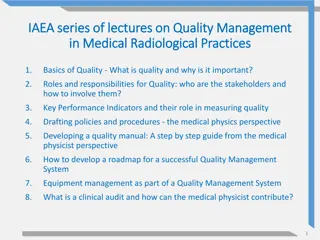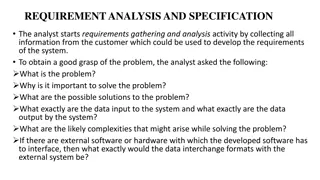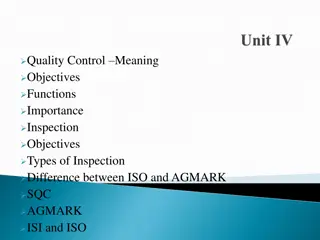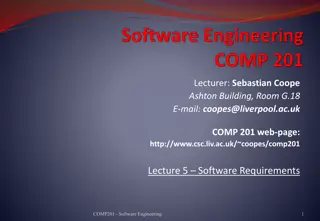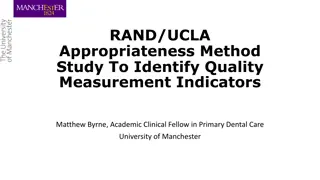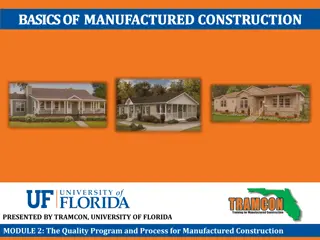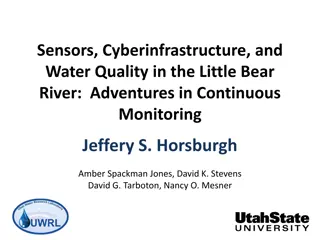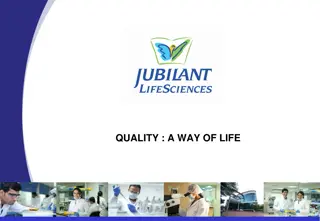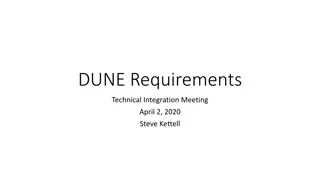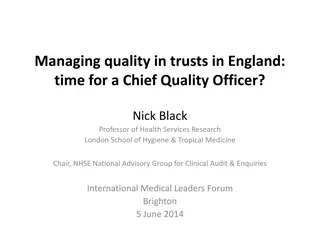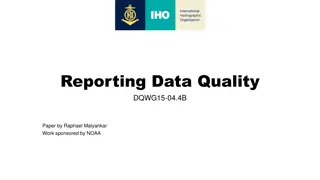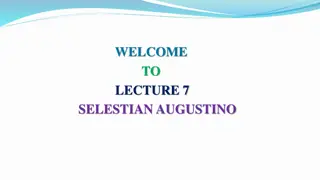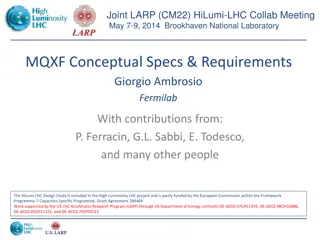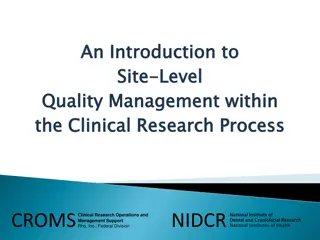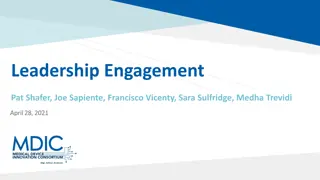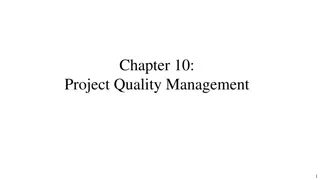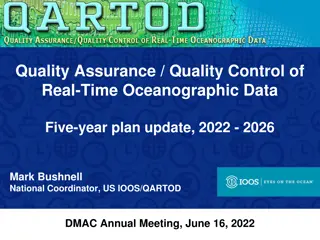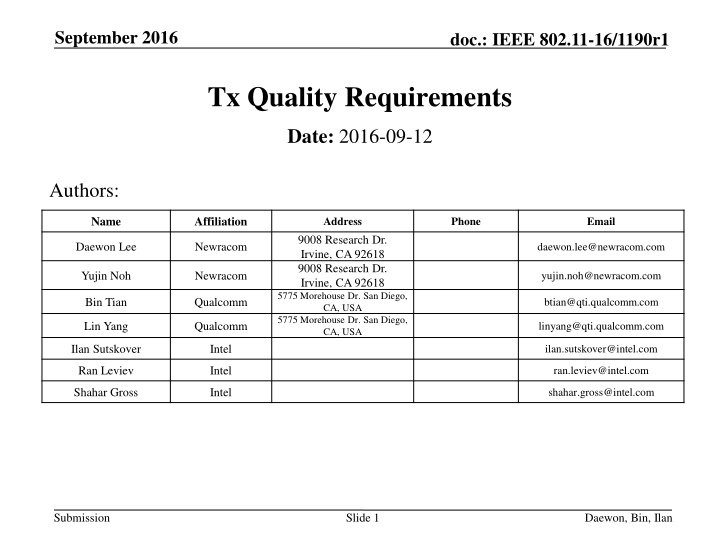
IEEE 802.11-16/1190r1 Tx Quality Requirements September 2016 Document
Explore the IEEE 802.11-16/1190r1 document detailing Transmission (Tx) Quality Requirements as of September 2016. This comprehensive report covers authors, affiliations, addresses, and contact details for key contributors from various organizations including Newracom, Qualcomm, Intel, and Marvell. Gain insights into the technical aspects and advancements in wireless communication technologies discussed in this document.
Download Presentation

Please find below an Image/Link to download the presentation.
The content on the website is provided AS IS for your information and personal use only. It may not be sold, licensed, or shared on other websites without obtaining consent from the author. If you encounter any issues during the download, it is possible that the publisher has removed the file from their server.
You are allowed to download the files provided on this website for personal or commercial use, subject to the condition that they are used lawfully. All files are the property of their respective owners.
The content on the website is provided AS IS for your information and personal use only. It may not be sold, licensed, or shared on other websites without obtaining consent from the author.
E N D
Presentation Transcript
September 2016 doc.: IEEE 802.11-16/1190r1 Tx Quality Requirements Date: 2016-09-12 Authors: Name Affiliation Address Phone Email 9008 Research Dr. Irvine, CA 92618 9008 Research Dr. Irvine, CA 92618 5775 Morehouse Dr. San Diego, CA, USA 5775 Morehouse Dr. San Diego, CA, USA Daewon Lee Newracom daewon.lee@newracom.com Yujin Noh Newracom yujin.noh@newracom.com Bin Tian Qualcomm btian@qti.qualcomm.com Lin Yang Qualcomm linyang@qti.qualcomm.com Ilan Sutskover Intel ilan.sutskover@intel.com Ran Leviev Intel ran.leviev@intel.com Shahar Gross Intel shahar.gross@intel.com Submission Slide 1 Daewon, Bin, Ilan
September 2016 doc.: IEEE 802.11-16/1190r1 Authors (continued) Name Affiliation Address Phone Email Yongho Seok yongho.seok@newracom.com Young Hoon Kwon younghoon.kwon@newracom.com 9008 Research Dr. Irvine, CA 92618 Newracom Reza Hedayat reza.hedayat@newracom.com Minho Cheong Ron Porat Sriram Venkateswaran Matthew Fischer Zhou Lan Leo Montreuil Andrew Blanksby Vinko Erceg Thomas Derham Mingyue Ji minho.cheong@newracom.com rporat@broadcom.com mfischer@broadcom.com Broadcom Submission Slide 2 Daewon, Bin, Ilan
September 2016 doc.: IEEE 802.11-16/1190r1 Authors (continued) Name Affiliation Address Phone Email Robert Stacey robert.stacey@intel.com Shahrnaz Azizi shahrnaz.azizi@intel.com Po-Kai Huang po-kai.huang@intel.com Qinghua Li 2111 NE 25th Ave, Hillsboro OR 97124, USA quinghua.li@intel.com +1-503-724- 893 Xiaogang Chen xiaogang.c.chen@intel.com Intel Chitto Ghosh chittabrata.ghosh@intel.com Laurent Cariou laurent.cariou@intel.com Yaron Alpert yaron.alpert@intel.com Assaf Gurevitz Feng Jiang assaf.gurevitz@intel.com feng1.jiang@intel.com Submission Slide 3 Daewon, Bin, Ilan
September 2016 doc.: IEEE 802.11-16/1190r1 Authors (continued) Name Affiliation Address Phone Email Hongyuan Zhang hongyuan@marvell.com Lei Wang Leileiw@marvell.com Liwen Chu liwenchu@marvell.com Jinjing Jiang jinjing@marvell.com Yan Zhang yzhang@marvell.com Rui Cao ruicao@marvell.com 5488 Marvell Lane, Santa Clara, CA, 95054 Sudhir Srinivasa sudhirs@marvell.com Marvell 408-222-2500 Bo Yu boyu@marvell.com Saga Tamhane sagar@marvell.com Mao Yu my@marvel..com Xiayu Zheng xzheng@marvell.com Christian Berger crberger@marvell.com Niranjan Grandhe ngrandhe@marvell.com Hui-Ling Lou hlou@marvell.com Submission Slide 4 Daewon, Bin, Ilan
September 2016 doc.: IEEE 802.11-16/1190r1 Authors (continued) Name Affiliation Address Phone Email 5775 Morehouse Dr. San Diego, CA, USA Straatweg 66-S Breukelen, 3621 BR Netherlands 5775 Morehouse Dr. San Diego, CA, USA 1700 Technology Drive San Jose, CA 95110, USA 5775 Morehouse Dr. San Diego, CA, USA 5775 Morehouse Dr. San Diego, CA, USA 5775 Morehouse Dr. San Diego, CA, USA 5775 Morehouse Dr. San Diego, CA, USA 5775 Morehouse Dr. San Diego, CA USA Straatweg 66-S Breukelen, 3621 BR Netherlands 2100 Lakeside Boulevard Suite 475, Richardson TX 75082, USA 1060 Rincon Circle San Jose CA 95131, USA Straatweg 66-S Breukelen, 3621 BR Netherlands Alice Chen alicel@qti.qualcomm.com Albert Van Zelst allert@qti.qualcomm.com Alfred Asterjadhi aasterja@qti.qualcomm.com Carlos Aldana caldana@qca.qualcomm.com George Cherian gcherian@qti.qualcomm.com Gwendolyn Barriac gbarriac@qti.qualcomm.com Hemanth Sampath hsampath@qti.qualcomm.com Qualcomm Lin Yang linyang@qti.qualcomm.com Lochan Verma lverma@qti.qualcomm.com Menzo Wentink mwentink@qti.qualcomm.com Naveen Kakani nkakani@qti.qualcomm.com Raja Banerjea rajab@qit.qualcomm.com Richard Van Nee rvannee@qti.qualcomm.com Submission Slide 5 Daewon, Bin, Ilan
September 2016 doc.: IEEE 802.11-16/1190r1 Authors (continued) Name Affiliation Address Phone Email 1700 Technology Drive San Jose, CA 95110, USA 5775 Morehouse Dr. San Diego, CA, USA 5775 Morehouse Dr. San Diego, CA, USA 1700 Technology Drive San Jose, CA 95110, USA 1700 Technology Drive San Jose, CA 95110, USA 1700 Technology Drive San Jose, CA 95110, USA Rolf De Vegt rolfv@qca.qualcomm.com Sameer Vermani svverman@qti.qualcomm.com Simone Merlin smerlin@qti.qualcomm.com Qualcomm Tevfik Yucek tyucek@qca.qualcomm.com VK Jones vkjones@qca.qualcomm.com Youhan Kim youhank@qca.qualcomm.com Submission Slide 6 Daewon, Bin, Ilan
September 2016 doc.: IEEE 802.11-16/1190r1 Authors (continued) Name Affiliation Address Phone Email 2860 Junction Ave, San Jose, CA 95134, USA Jianhan Liu +1-408-526-1899 jianhan.Liu@mediatek.com Thomas Pare thomas.pare@mediatek.com chaochun.wang@mediatek.c om james.wang@mediatek.com ChaoChun Wang Mediatek USA James Wang Tianyu Wu tianyu.wu@mediatek.com russell.huang@mediatek.co m Russell Huang No. 1 Dusing 1st Road, Hsinchu, Taiwan James Yee +886-3-567-0766 james.yee@mediatek.com Mediatek Frank Hsu frank.hsu@mediatek.com Joonsuk Kim joonsuk@apple.com mujtaba@apple.com Aon Mujtaba Guoqing Li guoqing_li@apple.com Apple Eric Wong ericwong@apple.com Chris Hartman chartman@apple.com Jarkko Kneckt jkneckt@apple.com Submission Slide 7 Daewon, Bin, Ilan
September 2016 doc.: IEEE 802.11-16/1190r1 Authors (continued) Name Affiliation Address Phone Email F1-17, Huawei Base, Bantian, Shenzhen 5B-N8, No.2222 Xinjinqiao Road, Pudong, Shanghai 5B-N8, No.2222 Xinjinqiao Road, Pudong, Shanghai F1-17, Huawei Base, Bantian, Shenzhen 5B-N8, No.2222 Xinjinqiao Road, Pudong, Shanghai 5B-N8, No.2222 Xinjinqiao Road, Pudong, Shanghai 10180 Telesis Court, Suite 365, San Diego, CA 92121 NA F1-17, Huawei Base, Bantian, Shenzhen F1-17, Huawei Base, Bantian, Shenzhen F1-17, Huawei Base, Bantian, Shenzhen 10180 Telesis Court, Suite 365, San Diego, CA 92121 NA 303 Terry Fox, Suite 400 Kanata, Ottawa, Canada David X. Yang david.yangxun@huawei.com Jiayin Zhang zhangjiayin@huawei.com +86-18601656691 Jun Luo jun.l@huawei.com Yi Luo Roy.luoyi@huawei.com +86-18665891036 Yingpei Lin linyingpei@huawei.com Jiyong Pang pangjiyong@huawei.com Zhigang Rong zhigang.rong@huawei.com Jian Yu ross.yujian@huawei.com Huawei Ming Gan ming.gan@huawei.com Yuchen Guo guoyuchen@huawei.com Yunsong Yang yangyunsong@huawei.com Junghoon Suh Junghoon.Suh@huawei.com Peter Loc peterloc@iwirelesstech.com 303 Terry Fox, Suite 400 Kanata, Ottawa, Canada F1-17, Huawei Base, Bantian, Shenzhen F1-17, Huawei Base, Bantian, Shenzhen Edward Au edward.ks.au@huawei.com Teyan Chen chenteyan@huawei.com Yunbo Li liyunbo@huawei.com Submission Slide 8 Daewon, Bin, Ilan
September 2016 doc.: IEEE 802.11-16/1190r1 Authors (continued) Name Affiliation Address Phone Email Jinmin Kim Jinmin1230.kim@lge.com Kiseon Ryu kiseon.ryu@lge.com Jinyoung Chun jiny.chun@lge.com Jinsoo Choi js.choi@lge.com 19, Yangjae-daero 11gil, Seocho-gu, Seoul 137- 130, Korea Jeongki Kim jeongki.kim@lge.com LG Electronics Dongguk Lim dongguk.lim@lge.com Suhwook Kim suhwook.kim@lge.com Eunsung Park esung.park@lge.com JayH Park Hyunh.park@lge.com HanGyu Cho hg.cho@lge.com #9 Wuxingduan, Xifeng Rd., Xi'an, China Bo Sun sun.bo1@zte.com.cn Kaiying Lv Yonggang Fang Ke Yao Weimin Xing Brian Hart Pooya Monajemi lv.kaiying@zte.com.cn yfang@ztetx.com yao.ke5@zte.com.cn xing.weimin@zte.com.cn brianh@cisco.com pmonajem@cisco.com ZTE 170 W Tasman Dr, San Jose, CA 95134 Cisco Systems Submission Slide 9 Daewon, Bin, Ilan
September 2016 doc.: IEEE 802.11-16/1190r1 Authors (continued) Name Affiliation Address Innovation Park, Cambridge CB4 0DS (U.K.) Maetan 3-dong; Yongtong-Gu Suwon; South Korea 1301, E. Lookout Dr, Richardson TX 75070 Innovation Park, Cambridge CB4 0DS (U.K.) 1301, E. Lookout Dr, Richardson TX 75070 Maetan 3-dong; Yongtong-Gu Suwon; South Korea Phone Email Fei Tong f.tong@samsung.com +44 1223 434633 Hyunjeong Kang hyunjeong.kang@samsung.com +82-31-279-9028 Kaushik Josiam k.josiam@samsung.com (972) 761 7437 Samsung Mark Rison m.rison@samsung.com +44 1223 434600 Rakesh Taori rakesh.taori@samsung.com (972) 761 7470 Sanghyun Chang s29.chang@samsung.com +82-10-8864-1751 Yasushi Takatori takatori.yasushi@lab.ntt.co.jp +81 46 859 3135 Yasuhiko Inoue inoue.yasuhiko@lab.ntt.co.jp +81 46 859 5097 Shoko Shinohara Shinohara.shoko@lab.ntt.co.jp +81 46 859 5107 1-1 Hikari-no-oka, Yokosuka, Kanagawa 239-0847 Japan NTT Yusuke Asai asai.yusuke@lab.ntt.co.jp +81 46 859 3494 Koichi Ishihara ishihara.koichi@lab.ntt.co.jp +81 46 859 4233 Junichi Iwatani Iwatani.junichi@lab.ntt.co.jp +81 46 859 4222 3-6, Hikarinooka, Yokosuka-shi, Kanagawa, 239-8536, Japan Akira Yamada NTT DOCOMO yamadaakira@nttdocomo.com +81 46 840 3759 Submission Slide 10 Daewon, Bin, Ilan
September 2016 doc.: IEEE 802.11-16/1190r1 Authors (continued) Name Affiliation Address Phone Email Masahito Mori Masahito.Mori@jp.sony.com Yusuke Tanaka YusukeC.Tanaka@jp.sony.com Yuichi Morioka Sony Corp. Yuichi.Morioka@jp.sony.com Kazuyuki Sakoda Kazuyuki.Sakoda@am.sony.com William Carney William.Carney@am.sony.com Sigurd Schelstraete Sigurd@quantenna.com Quantenna Huizhao Wang hwang@quantenna.com Narendar Madhavan narendar.madhavan@toshiba.co.jp Masahiro Sekiya Toshihisa Nabetani Tsuguhide Aoki Tomoko Adachi Kentaro Taniguchi Toshiba Daisuke Taki Koji Horisaki David Halls Filippo Tosato Zubeir Bocus Fengming Cao Submission Slide 11 Daewon, Bin, Ilan
September 2016 doc.: IEEE 802.11-16/1190r1 Authors (continued) Name Affiliation Address Phone Email Cypress Semiconductor Corporation Sungeun Lee sungeun.lee@cypress.com Saishankar Nandagopalan snan@cypress.com Stephane Baron stephane.baron@crf.canon.fr Pascal Viger Canon pascal.viger@crf.canon.fr Patrice Nezou patrice.nezou@crf.canon.fr Submission Slide 12 Daewon, Bin, Ilan
September 2016 doc.: IEEE 802.11-16/1190r1 Open or Missing TX Quality Requirements Full bandwidth masks defined RBW/VBW missing OFDMA signals quality requirements open Spectral flatness open Frequency and symbol clock error open Time of departure accuracy open LO leakage level defined 80+80 MHz requirement missing Submission Slide 13 Daewon, Bin, Ilan
September 2016 doc.: IEEE 802.11-16/1190r1 Tx Clock Error Proposal: Transmit subcarrier frequency and symbol clock error o Same as 11ac (+/- 20ppm) except for trigger-based PPDU Time of departure accuracy o Same as 11ac Submission Slide 14 Daewon, Bin, Ilan
September 2016 doc.: IEEE 802.11-16/1190r1 RBW and VBW for Tx Mask 11ac specification RBW o 11a/n/ac: 100kHz VBW o 11 a/n/ac: 30kHz Proposal: RBW o 11ax: 25kHz due to carrier spacing o Narrower RBW may also help in mask compliance VBW o 11ax: 7.5kHz Same scaling as the RBW Smaller VBW leads to better averaging. Benefit 11ax which may boosted STF/LTF and changing BW between pre-HE and HE portion Submission Slide 15 Daewon, Bin, Ilan
September 2016 doc.: IEEE 802.11-16/1190r1 Spectral Mask Spectral mask Measuring total out-of-band emission power (orthogonal and non- orthogonal interferences) Good for controlling the adjacent channel interference impact to a non-synchronized receiver (like OBSS receiver) Not the be best tool for inter-RU interference control Proposal: Every packet type should conform to the full bandwidth mask, to avoid excess leakage to adjacent channels o Additional requirements to be put on narrowband OFDMA and preamble puncturing (i.e. non-contiguous channel bonding) o Spectral flatness required is discussed later in this contribution Submission Slide 16 Daewon, Bin, Ilan
September 2016 doc.: IEEE 802.11-16/1190r1 Whole BW Mask for OFDMA In UL OFDMA, narrow band data comes along with wideband (at least 20MHz) preamble For compliance testing, better testing the whole packet instead of using special testing mode with HE portion only Preamble power is proportional to RU bandwidth and packet duration o Preamble PSD level is at least 10*log10[(Preamble BW)/(RU BW)] lower than the HE portion which makes it easy to meet the mask 0 1st RU52 11ax20 mask -10 -20 -30 PSD [dBr] -40 -50 -60 -70 -30 -20 -10 0 10 20 30 Frequency [MHz] Submission Slide 17 Daewon, Bin, Ilan
September 2016 doc.: IEEE 802.11-16/1190r1 Spectral Flatness Spectral flatness is required to ensure that mask compliance is not achieved by power boosting a subcarrier beyond reasonable level Proposal: Spectral flatness should be tested as in 11ac, with the following exceptions: o Used RUs only to be considered o RU boosting and BF should not be used when measuring spectral flatness Spectral flatness should have same +4/-6 dB limit (as in 11ac) Note: spectral flatness is tested after GI removal and uses FFT output Submission Slide 18 Daewon, Bin, Ilan
September 2016 doc.: IEEE 802.11-16/1190r1 11ax 20/40/80/160MHz Spectral Flatness Propose to have same maximum deviation requirement as 11ac, re-calculate the tone indices for averaging, based on 11ax numerology For 20MHz: use same indices as 11ac 80MHz For 40MHz: outer most INNER subcarrier = 84*244/122 = 168 For 80MHz: outer most INNER subcarrier = floor(168*500/244) = 344 For 160/80+80MHz: outer most INNER subcarrier = floor(168*1012/244) = 696 Inner most INNER subcarrier = (1024-696)/2+2 = 166 Submission Slide 19 Daewon, Bin, Ilan
September 2016 doc.: IEEE 802.11-16/1190r1 11ax Spectral Flatness Table Proposal Transmission BW(MHz) Averaging subcarrier indices (inclusive) Maximum Deviation (dB) Tested subcarrier indices (inclusive) -84 to -2 and +2 to +84 4 20 -84 to -2 and +2 to +84 -122 to -85 and +85 to +122 +4/-6 -168 to -3 and +3 to +168 4 -168 to -3 and +3 to +168 40 -244 to -169 and +169 to +244 +4/-6 -344 to -3 and +3 to +344 4 80 -344 to -3 and +3 to +344 -500 to -345 and +345 to +500 +4/-6 -696 to -515, -509 to -166, +166 to +509, and +515 to +696 4 -696 to -515, -509 to -166, +166 to +509, and +515 to +696 160/80+80 -1012 to -697, -165 to -12, +12 to +165, and +697 to +1012 +4/-6 Submission Slide 20 Daewon, Bin, Ilan
September 2016 doc.: IEEE 802.11-16/1190r1 TX EVM for Full BW (Except for Full BW UL-MIMO) Proposal: Non DCM: o MCS0 to 9 the same as 11ac o MCS 10 and 11 already motioned DCM + MCS0, DCM + MCS1: o Same as MCS0 DCM + MCS 3: o Same as MCS 1 DCM + MCS 4: o Same as MCS 2 For trigger based full BW MU-MIMO PPDU, further investigation is needed for the impact of EVM to cross-stream interference Submission Slide 21 Daewon, Bin, Ilan
September 2016 doc.: IEEE 802.11-16/1190r1 Used Tone EVM for UL OFDMA Transmissions The definition of used tone EVM is the same as the full BW EVM except that EVM is computed for the transmitted RU The transmitted RU shall conform to its own EVM requirement EVM requirement is per MCS No more than one RU used in a triggered UL PPDU, but multiple RUs in DL OFDMA for example In order to control the interference to other RUs, for non full bandwidth OFDMA transmission, EVM for UL OFDMA may require some changes compared with full BW cases. Details are TBD Note Appendix contain information on how LTE regulates UL OFDMA transmission Submission Slide 22 Daewon, Bin, Ilan
September 2016 doc.: IEEE 802.11-16/1190r1 Tx EVM for DL OFDMA Proposal: EVM shall be computed for each transmitted RU separately and is subject to the EVM limit associated with the MCS of that RU Submission Slide 23 Daewon, Bin, Ilan
September 2016 doc.: IEEE 802.11-16/1190r1 Controlling Maximal Interference Outside of the Transmitted RU Full BW mask is useless (see picture) 0 1st RU52 11ax20 mask -10 -20 Adjacent RX tests are highly complicated and not too informative Test equipment is both TX and RX -30 PSD [dBr] -40 -50 -60 -70 -30 -20 -10 0 10 20 30 Frequency [MHz] Mask-like test is less recommended Insensitive to MCS, whereas MCS selection is a primary tool of the AP so loses information We propose to use EVM-like test MCS dependent Submission Slide 24 Daewon, Bin, Ilan
September 2016 doc.: IEEE 802.11-16/1190r1 TX EVM for UL OFDMA For UL OFDMA, EVM concept can be expended to ensure the quality of UL OFDMA transmission Used tone EVM: control maximal distortion level in the transmitted RU Unused tone EVM: control maximal interference level outside of the transmitted RU, inside the PPDU bandwidth o Only the HE part is to be controlled by the requirements o Only important cases: (1) triggered uplink packets, (2) non-contiguous channel bonding Submission Slide 25 Daewon, Bin, Ilan
September 2016 doc.: IEEE 802.11-16/1190r1 Unused Tone EVM for UL OFDMA Transmissions Unused subcarriers carry interference to other RUs in triggered UL transmission The unused EVM of a subcarrier outside the RU is essentially calculated as the linear average power of that subcarrier normalized to the linear average power per subcarrier of the transmitted RU This is equivalent to EVM with respect to origin constellation Since unused tone EVM does not include normalization by estimated channel, it is in general SNR-like, and thus ~3dB lower than used tone EVM Submission Slide 26 Daewon, Bin, Ilan
September 2016 doc.: IEEE 802.11-16/1190r1 Unused tone EVM for UL OFDMA Transmissions (cont.) To avoid frequency selective variations of the unused tone EVM propose averaging over frequency intervals Recommended averaging over 26 subcarriers (2MHz) Whether to perform a interval based averaging or moving filter averaging is TBD Generally speaking, unused tone EVM is worst case when adjacent to the transmitted RU Prefer simple one unused tone EVM limit for all the unused tones and independent of RU size Submission Slide 27 Daewon, Bin, Ilan
September 2016 doc.: IEEE 802.11-16/1190r1 Unused tone EVM Proposal Proposal: Non full bandwidth UL-OFDMA transmissions shall comply with a maximum unused tone EVM limit. Unused tone EVM is defined as unused subcarrier power normalized by the average power per subcarrier of the transmitted RU, and averaged over 26 tones in linear domain Unused Tone EVM limit is set at TBD(s) below Used Tone EVM limit Submission Slide 28 Daewon, Bin, Ilan
September 2016 doc.: IEEE 802.11-16/1190r1 EVM Testing: LO Leakage For trigger-based PPDU, LO leakage may affect the EVM results and shall be excluded from the computation of both used or unused tone EVM Limit today is -32dBc, which for 52 tones is equal to -32+17=-15dBr Much higher than EVM levels typically LO leakage can show up in Center frequency of the PPDU tone plan and its +/- 3 tone neighbor Digital correction may be used for frequency precorrection for trigger based PPDU 20MHz operating devices: center of primary20 of the PPDU tone plan and +/- 3 tones 40MHz operating devices: center of the primary40 of the PPDU tone plan and +/- 3 tones Outside of the PPDU BW: e.g. 80MHz capable devices transmits 20MHz or 40MHz PPDU. Doesn t affect used tone and unused EVM Test equipment, not knowing exact LO location, can search for the worst used and unused EVM tone in the above possible LO locations and treat it is potential LO Exclude this tone from used or unused tone EVM measurement Apply LO leakage level requirement on this tone o o o Submission Slide 29 Daewon, Bin, Ilan
September 2016 doc.: IEEE 802.11-16/1190r1 EVM Testing: Time Correction 802.11ax is more sensitive to ICI due to timing error Longer OFDM symbols (4X) allow bigger timing drift to develop Higher MCSs require lower levels of EVM, which are more sensitive to timing errors The 802.11ac text specifies d) Symbols in a PPDU shall be derotated according to estimated frequency offset Proposal: add timing error correction d) Symbols in a PPDU shall be derotated according to estimated frequency offset. Sampling offset drift shall also be compensated. Submission Slide 30 Daewon, Bin, Ilan
September 2016 doc.: IEEE 802.11-16/1190r1 EVM Testing: Amplitude Compensation Background: Some implementation may additionally compensate amplitude on top of phase compensation for long packets. 11n/11ac EVM testing procedure does not explicitly enforce or discourage amplitude compensation in the test procedure. Issue: If test equipment tracks the PA s amplitude drift (cabled with each Tx path) for long packets especially with multi-streams (where different PA s hooked to different antennas may drift differently), good EVM will show up on the test equipment even though the intended receiver (over the air) sees bad EVM Proposal: Discourage a bad external PA implementation by adding a explicit text to not to compensate for amplitude drift during EVM testing Submission Slide 31 Daewon, Bin, Ilan
September 2016 doc.: IEEE 802.11-16/1190r1 LO Leakage Requirement for 80+80MHz 11ac LO leakage requirement for 80+80MHz was subject to spectral mask requirements. For an 80+80 MHz transmission where the RF LO falls outside both frequency segments, the RF LO shall additionally met the spectral mask requirements as defined in Transmit spectrum mask. Proposal: Add the same LO leakage requirement for 80+80MHz as in 11ac Submission Slide 32 Daewon, Bin, Ilan
September 2016 doc.: IEEE 802.11-16/1190r1 STRAWPOLLS Submission Slide 33 Daewon, Bin, Ilan
September 2016 doc.: IEEE 802.11-16/1190r1 Straw Poll #1 Do you agree to the following? Limit subcarrier frequency error and symbol clock error at +/- 20ppm, except for trigger-based PPDU. Keep time of departure accuracy same as in 802.11ac. Y/N/A Submission Slide 34 Daewon, Bin, Ilan
September 2016 doc.: IEEE 802.11-16/1190r1 Straw Poll #2 Do you agree that full bandwidth masks for HE PPDUs are tested with RBW=25kHz and VBW=7.5kHz? Y/N/A Submission Slide 35 Daewon, Bin, Ilan
September 2016 doc.: IEEE 802.11-16/1190r1 Straw Poll #3 Do you agree that every 11ax PPDU is compliant with the full PPDU bandwidth mask? Y/N/A Submission Slide 36 Daewon, Bin, Ilan
September 2016 doc.: IEEE 802.11-16/1190r1 Straw Poll #4 Do you agree that Spectral Flatness is tested for HE PPDUs similarly to 11ac, with the following modifications? RU boosting and beamforming shall not be applied during test Only non-zero RUs participate in the flow Note: spectral flatness is measured on the HE portion only, after GI removal and uses FFT output Y/N/A Submission Slide 37 Daewon, Bin, Ilan
September 2016 doc.: IEEE 802.11-16/1190r1 Straw Poll #5 Do you prefer which of the following spectrum flatness requirement Same as 11ac except tone index adjusted for 11ax tone plan as shown in Slide #19 Y/N/A Submission Slide 38 Daewon, Bin, Ilan
September 2016 doc.: IEEE 802.11-16/1190r1 Straw Poll #6 Do you agree that following EVM requirements for full BW transmission except for the HE triggered MU- MIMO PPDU? Non DCM: MCS0 to 9 the same as 11ac; DCM+MCS0 and DCM+MCS1 the same as MCS0 no DCM DCM+MCS3 the same as MCS1 no DCM DCM+MCS4 the same as MCS2 no DCM HE triggered MU-MIMO PPDU EVM requirements are TBD Y/N/A Submission Slide 39 Daewon, Bin, Ilan
September 2016 doc.: IEEE 802.11-16/1190r1 Straw Poll #7 Do you agree that for an DL OFDMA PPDU, EVM shall be computed for each transmitted RU separately and is subject to the EVM limit associated with the MCS of that RU? Y/N/A Submission Slide 40 Daewon, Bin, Ilan
September 2016 doc.: IEEE 802.11-16/1190r1 Straw Poll #8 Do you agree that non full bandwidth UL OFDMA transmissions shall comply with a maximum unused tone EVM limit? Maximum unused tone EVM limit is defined as unused subcarrier power normalized to the average power per subcarrier of the transmitted RU and averaged over 26 tones Unused tone EVM limit is set at TBD(s) below used tone EVM limit Y/N/A Submission Slide 41 Daewon, Bin, Ilan
September 2016 doc.: IEEE 802.11-16/1190r1 Straw Poll #9 Do you agree that for trigger based PPDU LO leakage shall be excluded from used tone and unused tone EVM computation? The LO leakage exclusion method is described in slide #28 Y/N/A Submission Slide 42 Daewon, Bin, Ilan
September 2016 doc.: IEEE 802.11-16/1190r1 Straw Poll #10 Do you agree to add the following to EVM test procedure? Sampling offset drift shall also be compensated Y/N/A Submission Slide 43 Daewon, Bin, Ilan
September 2016 doc.: IEEE 802.11-16/1190r1 Straw Poll #11 Do you agree to add the same LO leakage restriction for 80+80MHz transmission as 11ac to 11ax? For an 80+80 MHz transmission where the RF LO falls outside both frequency segments, the RF LO shall additionally met the spectral mask requirements as defined in X.X.X.X (Transmit spectrum mask). Y/N/A Submission Slide 44 Daewon, Bin, Ilan
September 2016 doc.: IEEE 802.11-16/1190r1 Straw Poll #12 Do you agree to add the following to EVM test procedure? Amplitude drift shall not be compensated by the testing instrument Y/N/A Submission Slide 45 Daewon, Bin, Ilan
September 2016 doc.: IEEE 802.11-16/1190r1 Straw Poll #13 Do you agree to accept the proposed text changes in comment resolution document 11-16-1191-02-00ax comment-resolution-for-cids-on-phy-transmit-spec ? Y/N/A (Passed without objection) Submission Slide 46 Daewon, Bin, Ilan
September 2016 doc.: IEEE 802.11-16/1190r1 References [1] 11-16-xxxx-00-00ax comment-resolution-for-cids- on-phy-transmit-spec Submission Slide 47 Daewon, Bin, Ilan
September 2016 doc.: IEEE 802.11-16/1190r1 APPENDIX Submission Slide 48 Daewon, Bin, Ilan
September 2016 doc.: IEEE 802.11-16/1190r1 Simulated Measurements of Unused Tone EVM (1/3) Simulation Model Measurement: o Not an actual measurement o Power measure after GI removal and FFT o Based on models and tested on Matlab Non-linearity Modeling: o AM-AM and AM-PM distortion of PA modeled LO leakage: -35dBc Residual CFO: >0.01ppm I-Q imbalance: > 0.1dB amplitude, > 0.1 degree phase Tx IPN: -36dBc PPDU BW: 80MHz RUs Under Test: 26-Tone RU #6 and 242-Tone RU #2 Submission Slide 49 Daewon, Bin, Ilan
September 2016 doc.: IEEE 802.11-16/1190r1 Simulated Measurements of Unused Tone EVM (2/3) Submission Slide 50 Daewon, Bin, Ilan

